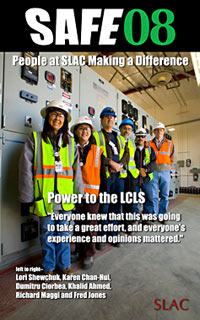

Wednesday - April 30, 2008
SLAC Today is
available online at:
http://today.slac.stanford.edu
In this issue:
SAFE '08 Success Story: Power to the LCLS
People Today: Outside the Lens, Inside the Shoes of Harvey Lynch
New Requisition Priority System for Purchasing
Conservation Tip of the Week
 |
 |
|
Wednesday - April 30, 2008 |
 SAFE '08 Success Story:
|
||
|
|
||

Outside the Lens, Inside the Shoes of Harvey Lynch
One of the greatest compliments he has ever received, he says, took place during a discussion about how to proceed with BaBar's construction. "After a comment I made, a colleague called me an intellectual terrorist. It sounds strange, but he meant it as a compliment." Lynch is a proverbial outside-of-the-box kind of guy; the type to stand back and take a fresh look at things. It should come as no surprise that his hobbies match his colorful personality. Part of his adroitness with solving problems comes from his eye for detail—an eye that's grown sharp from decades of photography. The earliest pictures Lynch still has are from Yellowstone National Park, where his family stopped on a road trip. He still remembers the exact make of the camera, a Kodak Baby Brownie, which he first used as a six-year-old. When SLAC hosts events, Lynch often roams through the crowds, camera in hand. However, his real fascination with photography lies in "inanimate nature photography," which he always shoots in black and white. "Color is seductive," he says. "If the color is wrong that is all you'll ever see, whereas black and white photos force the viewer to concentrate on the subject." Lynch modeled his approach to photography after his hero, Edward Weston. A photographer overshadowed in the public eye by his successor, Ansel Adams, Weston was famous for capturing nature in a way that resonates slowly. "There's more subtlety to Weston," Lynch said. "In terms of pure subject matter, Weston is the photographer of all time, really." Lynch finds meaning and joy in life's subtleties. A fan of classical music, he travels to the annual Carmel Bach Festival nearly every year. There he spends his days shooting photos at places like Point Lobos, Big Sur and Garrapata Beach and his evenings attending concerts. "It's a spectacular week," he said. "Few things can compare to the combination of great music and California's beautiful landscape." |
New Requisition Priority System for PurchasingEffective May 1, requestors will be able to prioritize purchase requisitions entered into PeopleSoft as either routine (normal lead time), priority (needs special attention), or emergency (mission critical). Normal lead times don't apply to emergencies. Emergencies will be expedited by the buyer as much as possible. This new system is the result of a SLAC Improvement Initiative Customer Process Improvement Team recommendation and should provide for a more efficient method of requisition processing. If you have any questions, please contact Alan Kong (x4138) or Bob Todaro (x2425). Conservation Tip
|
Events
Access (see all)Announcements
|
| | ||
|
|
||
 <%
Response.AddHeader "Last-modified", getArticleDate()
'Response.AddHeader "Last-modified","Mon, 01 Sep 1997 01:03:33 GMT"
'Monday, December 06, 2010
%>
<%
Response.AddHeader "Last-modified", getArticleDate()
'Response.AddHeader "Last-modified","Mon, 01 Sep 1997 01:03:33 GMT"
'Monday, December 06, 2010
%>View online at http://today.slac.stanford.edu/. |
||